Reports of mermaid encounters were not uncommon in 19th-century Japan, and a number of illustrated documents from that period -- including a few by notable natural historians -- depict some fantastic specimens rarely seen in today's world.
* * * * *
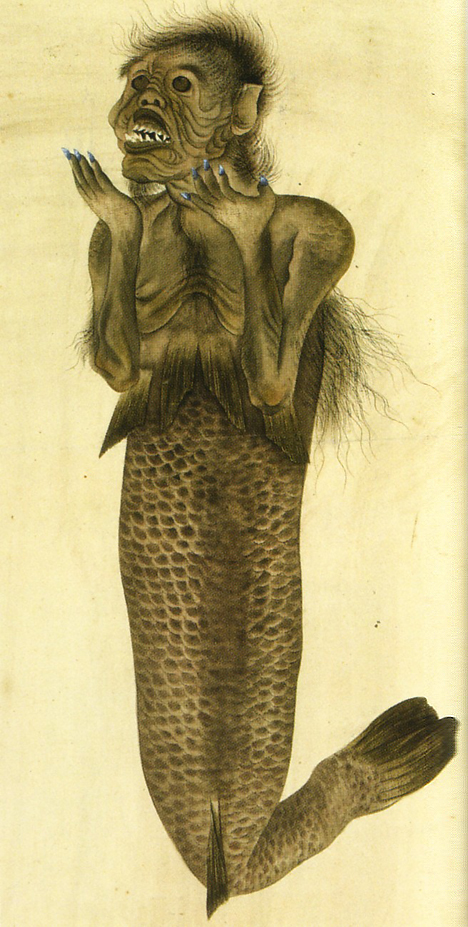
Mermaid illustration obtained by Blomhoff, late Edo period (artist unknown)
This mermaid illustration from the National Museum of Ethnology (Leiden, Netherlands) was obtained by Dutch trader Jan Cock Blomhoff, who served as director of the Dejima trading post in Nagasaki from 1817 to 1824. The drawing appears to show a different mermaid than Blomhoff's famous mummified specimen, which is also owned by the museum.
* * * * *
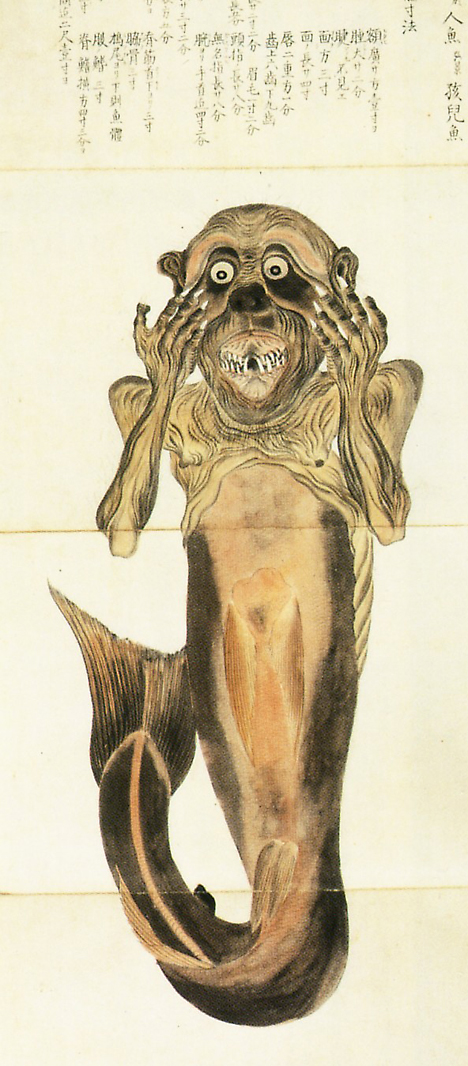
Noted natural historian Baien Mouri (1798-1851), a prolific illustrator known for his colorful depictions of plants and animals, included two sketches of a mermaid in his 1835 book Baien Gyofu ("Baien Book of Fish").

No apparent effort was made to distinguish the mermaid drawings from the dozens of other illustrations of known sea animals that appear in the book.
* * * * *

[Enlarge]
This 1805 illustration (artist unknown) from the Waseda University Theater Museum shows a mermaid that was reportedly captured in Toyama Bay. According to the accompanying text, the creature measured 10.6 meters (35 ft) long.
* * * * *
Keisuke Ito (1803–1901) -- a.k.a. the father of modern Japanese botany -- was a noted botanist, medical practitioner, and prolific natural history illustrator. He included several mermaid illustrations in his books, which consisted mostly of drawings of known animals.
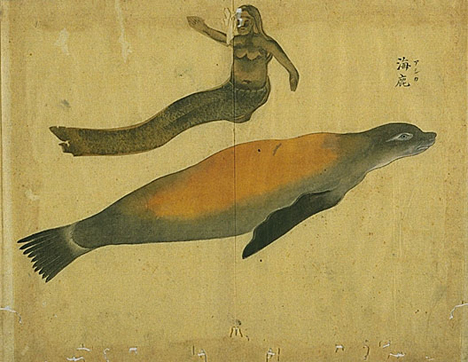
Ito's illustrated Kinka Juufu ("Book of Beasts") included a drawing of a mermaid swimming alongside an Australian sea lion (Zalophus lobatus).
* * * * *
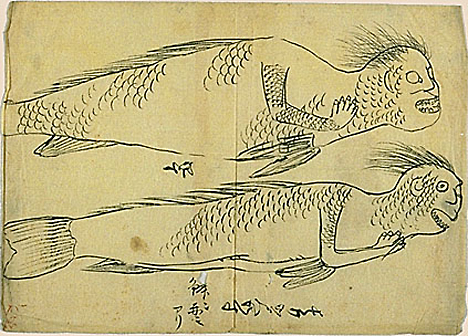
Kinka Gyofu ("Book of Fish"), another illustrated work by Ito, included a depiction of scaly mermaids measuring about 67 centimeters (26 in) long.
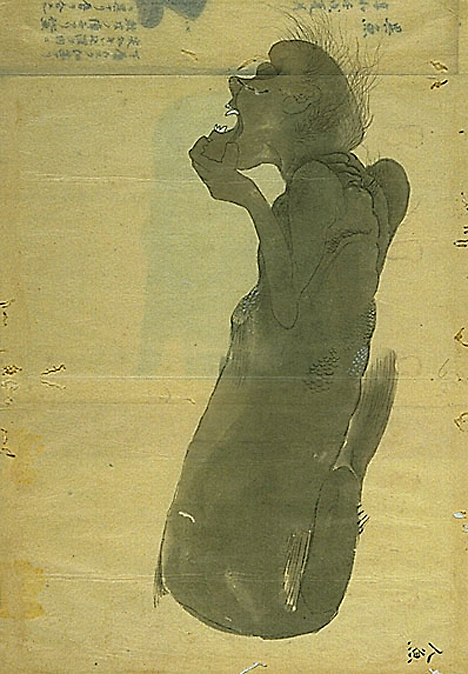
Ito also included this pair of mermaid illustrations in Kinka Gyofu with no apparent effort to distinguish them from the hundreds of other known fish and sea animals pictured in the book.
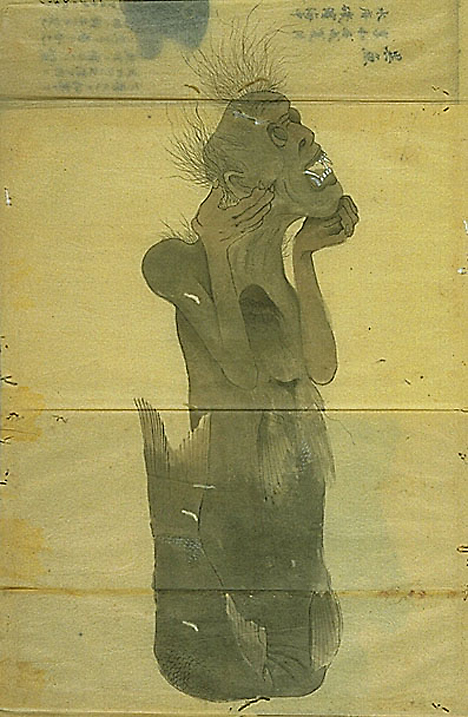
It is unclear whether these illustrations were based on actual observations. Were they the product of an overactive imagination? Were they deliberate fabrications? Or did mermaids once inhabit the waters of Japan?

nikki
Fascinating!
[]J. J. Markin
I'm willing to bet most, perhaps all, of those are "Feejee mermaids": upper body of monkey attached to fish tail. P.T. Barnum made quite a splash (so to speak) with his, as you'll recall. There was one in the Ripley Museum in Atlantic City, N.J., when I went there some ten years ago, and I *think* (but am no longer sure) there was one in the late lamented Dime Museum up in Baltimore.
[]Hayley
J. J., don't be an idiot. The Fiji mermaids were inspired from these drawings. Not the other way around.
[]Michael
Yeah, the most likely explanation for these depictions are encounters with dugongs (sea cows) which have a natural range covering the South Pacific and would have definitely been encountered by Japanese mariners. Being from Florida the very first thing I thought when seeing these pictures was...MANATEE. Fascinating to see the odd, macabre details the Japanese imagination imposed on these creatures.
[]Ryan
Some more cracking illustrations: great find.
[]Dom
wow! these images are fantastic.
I read in the November issue of "fortean times" that some times chinese and japanese fishermen would would make these mermaids and sell them to gullible european fishermen. They were then taken on tour but rarely given credit by scientists.
[]Shovel
Maybe it was swimmers half-swallowed by very large fish.... the corpse of the swimmer being pushed around by the fish for days or longer as the fish slowly chokes to death.. ?
[]rickpetes
That's an interesting idea.
[]J. J. Markin
The graphics presented all date to the same period when the taxidermied "mermaids" (aka "Feejee" mermaids), or references to same, many (most?) of them apparently from Japan, start appearing in numbers in the West -- i.e. the 19th century. Or thus I have been led to believe in every source I have ever consulted on the matter. They also very closely resemble the taxidermied specimens. Ms / Mr / Dr (?) Hayley, your knowledge must far exceed mine, for you obviously know of illustrations in this same vein that precede the ones shown by a significant amount of time, thus proving that the taxidermied versions are copies of the illustrations instead of the other way around, but alas you have forgotten to add even the most informal of citations. What is, btw, the most authoritative source on Feejee mermaids? I have not encountered much scholarly literature on the subject.
[]drzza
or perhaps they resemble the nommos of the Dogon tribe in Mali? it is curious to see what ancient cultures had interactions with these so called mythical creatures. then again what is the connection between Africa and Japan mythology anyhow...curious indeed!
[]Roger
The illustrations look more like corpses than mermaids.
[]abhi
Some says that it is from indonesia. I got it in my mail also. Is it real?
[]Fer
Actually the pictures do look like a very big fish swallowed a human almost whole, and the upper parts do look like a dead human. Very good observation Shovel. And pretty scary by the way.
[]Geekrot
why are they all clasping their hands in agony?
[]Feejee Mermaid
http://www.youtube.com/watch?v=s5Z1qcaWl2A
[]aleksandra
wow these are fantastic. thank you for posting
[]